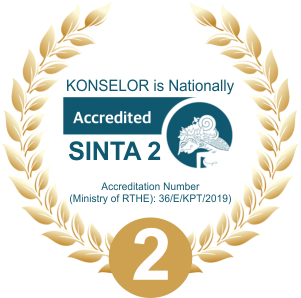Hubungan Gaya Belajar dan Keterampilan Belajar dengan Hasil Belajar Mahasiswa Serta Implikasinya dalam Pelayanan Bimbingan dan Konseling di Fakultas Ilmu Pendidikan Universitas Negeri Padang
 ), A Muri Yusuf(2), Neviyarni S(3),
), A Muri Yusuf(2), Neviyarni S(3), (1)
(2) Universitas Negeri Padang
(3) Universitas Negeri Padang
 Corresponding Author
Corresponding Author
Copyright (c) 2017
DOI : https://doi.org/10.24036/02017615734-0-00
Full Text:
 Language : id
Language : id
Abstract
Keywords
References
Ardi, Z. (2014). Cita-cita Perkerjaan dan Pilihan Peminatan Siswa Sekolah Menengah Atas Negeri di Sumatera Barat. UNIMED Repository
Biggs, J. B. (2011). Teaching for quality learning at university: What the student does. McGraw-Hill Education (UK).
Daharnis, D., & Ardi, Z. (2016). The Compatibility Student Choice of University Majoring; A Preliminary Studies. Guidena: Jurnal Ilmu Pendidikan, Psikologi, Bimbingan dan Konseling, 6(1), 101-109.
Daharnis. (2005). “Hubungan Sejumlah Karakteristik Mahasiswa, Kondisi Lingkungan, Pembelajaran, Kegiatan Belajar & Prestasi Belajar Mahasiswa Universitas Negeri Padang”. Disertasi tidak diterbitkan. Malang: Program Pascasarjana Universitas Negeri Malang.
Daharnis. (2011a). “Analisis Hasil Belajar Mahasiswa Jurusan Bimbingan dan Konseling FIP UNP Ditinjau dari Mutu Kegiatan Belajar, Angkatan, Status Masuk & Jenis Kelamin”. Laporan Penelitian. Padang: UNP.
Daharnis. (2011b). “Hubungan Aspirasi, Persepsi, Locus of Control, Angkatan & Status Masuk dengan Kegiatan Belajar Mahasiswa Jurusan Bimbingan dan Konseling FIP UNP”. Laporan Penelitian. Padang: UNP.
Dede, C. (2005). Planning for neomillennial learning styles: Implications for investments in technology and faculty. Educating the net generation, 5.
Djamarah, S.B. & Zain, A. (2002). Strategi Belajar Mengajar. Jakarta: Rineka Cipta.
Elliott, S.N., dkk. (2000). Educational Psychology: Effective teaching, effective learning. Dubuque: Brown & Benchmark.
Gie, T.L. (1995). Cara Belajar yang Efisien. Yogyakarta: Liberty.
Hasibuan, A. (2008). “Efektivitas Layanan Bimbingan Kelompok dalam Meningkatkan Mutu Keterampilan Belajar (Studi Eksperimen di SMP Negeri 2 Padang)”. Tesis tidak diterbitkan. Padang: Pascasarjana UNP.
Herwanti, S. (2009). “Efektivitas Layanan Bimbingan Kelompok dalam Meningkatkan Pemahaman Keterampilan Belajar Siswa untuk Menghadapi Ujian”. Tesis tidak diterbitkan. Padang: Pascasarjana UNP.
Margowati, D. (2009). Penerapanmodel Pembelajaran Kolaboratif Disertai Strategi Quantum Learning dalam Meningkatkan Hasil Belajar Biologi (Doctoral dissertation, Universitas Sebelas Maret).
Prayitno, dkk. (2002). Seri Latihan Keterampilan Belajar Program Semi-Que IV. Padang: Depdiknas.
Prayitno. (2007). Potensi Mahasiswa. Padang: UNP Press.
Pristiani, I. (2013). Cara Meningkatkan Hasil Belajar, (Online), (http://www .ilawati-apt.com/cara-meningkatkan-hasil-belajar, diakses 30 Maret 2015).
Riduwan. (2012). Pengantar Statistika Sosial. Bandung: Alfabeta.
Sedanayasa, G. (2003). “Model Kolaborasi Pembimbing & Guru dalam Peningkatan Keterampilan Belajar Siswa dengan Pendekatan Multimodal”. Disertasi UPI.
Suryabrata, S. (2006). Psikologi Pendidikan. Bandung: Alfabeta.
Tanta. (2010). “Pengaruh Gaya Belajar terhadap Hasil Belajar Mahasiswa pada Mata Kuliah Biologi Umum Universitas Cenderawasih”. Jurnal Kependidikan Dasar. Vol 1 No. 1.
Universitas Negeri Padang. (2013). Buku Pedoman Akademik Universitas Negeri Padang. Padang: UNP Press.
Yulianto, Y. (2011). Hubungan Antara Jenjang Pendidikan Orang Tua dan Motivasi Belajar dengan Prestasi Belajar Sosiologi pada Siswa Kelas XI SMA Negeri 1 Surakarta Tahun Ajaran 2010/2011 (Doctoral dissertation, Universitas Sebelas Maret).
 Article Metrics
Article Metrics
 Abstract Views : 5904 times
Abstract Views : 5904 times
 PDF (Bahasa Indonesia) Downloaded : 2289 times
PDF (Bahasa Indonesia) Downloaded : 2289 times
Refbacks
- There are currently no refbacks.
Copyright (c) 2017







